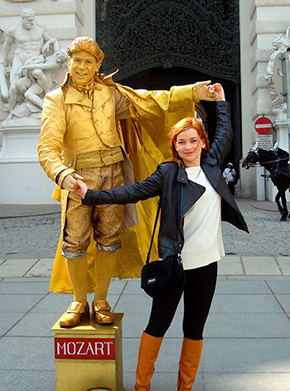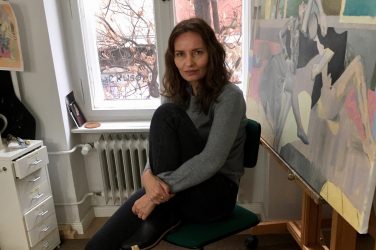In the wake of the debate on whether tourists are beneficial to cities or just annoying, Sintia Radu explains her experience and compares it to that of other young Europeans.
I first heard about the difference between tourists, travellers and visitors two months ago, while riding the Bucharest subway. An Ethiopian girl with the deepest eyes and biggest smile stared at me for a couple of minutes, holding a map and asking if anyone around spoke English. She then plucked up her courage and came to me to help her find a place in the city centre.
The golden Mozart in Vienna proves a hit amongst visitors.

“This is the first time in two weeks that I’m using a map,” she says. “I feel like such a tourist”.
“Ha-ha, but aren’t you a tourist?” I asked.
“Don’t call me that,” she yelled. “That’s so offensive”.
She got off the train, shuffling and dragging her humongous trolley bag, two cameras and a flowery sunhat, and left me googling the meaning of the word tourist. I thought it might be yet another word in English slang that I failed to understand. Turns out, there are a lot of definitions for people who travel in foreign parts. Thou shalt not confuse “traveler” (the one who’s there to explore the surroundings – with a “visitor” who is staying with relatives or friends and should be treated as a guest).
“Tourist” has by far the worst reputation. It may have started with humans building great cities, such as Paris or Rome and luring foreigners to come and stare at its palaces and cathedrals for centuries. Nowadays, it’s leading to riots against foreigners and fervid requests for tourists to go away, especially if they supposedly outnumber the locals (the 1.6 million Barcelona residents, for instance, are rallied against the 7.4 million tourists that visit their city every year). Inhabitants who feel deprived of their property and invaded by “I <3” t-shirts, fridge magnets and fold-out maps are driven to file complaints about noise, nudity, littering and public drunkenness.
Life in the small city
As a person living in one of the smallest capitals in the European Union, chasing tourists away seems almost outlandish: they bring money, make your city popular and offer a new perspective on tons of problems. But that’s because I was born and raised in Bucharest, whose population of roughly two million makes it no bigger than a New York City borough, in a country where traveling outside the borders was until 20 years ago just another foolish dream of those who struggled to release themselves from under the Communist spell. We knew very few foreign products and “tourist” was just a nickname for relatives from the countryside coming to visit the city.
The first real tourists I met were Israelis, many seduced by the new prospects of a young Romanian democracy and an equally new business market open after the ‘89 Revolution, who’d come to sell shampoos, open restaurants and meet beautiful women whom they always introduced as “you know, my very distant cousin”. Then there was that one Italian who couldn’t deal with Romanian food and spent hours cooking his famous homemade pasta recipe with no sauce and lots of God-sent Parmigiano-Reggiano. Last came the Hungarians, who owned the most amazing houses in Transylvania, a maze of freshly-cut wood, hand-knitted carpets and over-colourful doors and windows.
I first stepped foot on foreign territory seven years ago, in my first year of college for a one-week vacation in Budapest on New Year’s Eve. It was there that I encountered the first multinational community: French men disappointed with Hungarian wine, Chinese girls taking pictures of almost everything, Brits insisting that London will always be better. I came across different styles of dressing, different languages and accents, different looks and different souls, all gathered in what I still considered to be one of the most beautiful cities in Europe.

By now I’ve travelled the world and become accustomed to seeing equally disoriented faces, wandering around, clinging to their maps, fearing that the sun will set before they’d find their way. But I never truly got used to seeing them just right across the street from my building, because Bucharest, although cheap and very fun, is not Europe’s first-choice destination. That’s probably why, whenever I meet tourists in my city, I try to be the best of hosts and make them feel as much at home here as I do. If there’s one lesson I’ve learned in my travels it’s that places become beautiful because of the people we meet.
Those who tackle the something I’m not
“Tourists are so cliché,” says Hugo Imré Franco Takacs, who’s been living in Paris for eleven years. “Like they have the fanny pack, the tennis shoes, the yoga pants, and the wind breaker, and the baseball cap. I’m like ‘Good God, people, try and blend in’”. Things are pretty much the same in Vienna. “You recognise them easily: they stroll, they stop often and gaze at the buildings, at the way the roses are planted in the park, at all the juice brands sold at every sausage place,” says Adina Dumitru, a student in Vienna since 2012. “They take pictures with the golden Mozart from Schonbrunn, stride in the palace gardens and sometimes carry label bags with things bought on the main avenue.” Alexandru Bleotu, who’s lived in London for over four years, agrees. And “taken as a whole,” he says, “people who move slowly and stare at the sky, stop in the middle of the road and never seem to know where they’re actually going might become irritating.”
Anyone who works or dwells in an area worshiped by tourists will have wondered at some point how many computers in far-flung corners of the world their photographs have ended up gracing. And when you’re late in the morning, get used to jostling with hundreds of people in the dash for the office door. “Off-season, I ride the bike on Mariahilfer Straße and jog freely in the Schoenbrunn gardens,” Adina says. “Tourists make both activities seem like obstacle races. Also it gets harder to find a table in bars in the city center. I spend more time in line to get into the cool clubs and pay more attention to my belongings.” Yet it’s easy to love their stories and become fascinated with everything they represent. “If someone asks me for directions about what to visit, I gladly help them out”, Alexandru says. “Because I myself am a tourist sometimes in other places and I rely on people’s kindness. Also, the majority of the tourists are relaxed and eager to interact with others. They have a lot of interesting stories and it’s fun to hang out with them over a pint of beer”.

The secret of a non-invasive and likeable tourist boils down to stepping away from the checklist. “When I’m in my local bars and clubs where there are normally only French people, when there’s a foreigner there, I’m impressed”, Hugo says. “‘Who told you about my secret spot?’ And I’m like ‘That’s so courageous. That’s the way to travel. And when I travel, I want to go where the locals go. I want to find out where that local bar is where there are only Turkish people in Istanbul who are fans of electronic music, for example. When someone looks at me and thinks that I am a local and they’re asking for direction, I feel good about that. I feel like it’s a measure of success”.
Although I never really got used to loving crowds of people with tourist gears, I now humbly realise that complaining about that in Bucharest would be too much. Why’s that? Simply because there are others, in way more crowded areas, for whom things are more extreme. Tourists continue to bring me joy, even when I struggle to get away from any tourist attraction as fast as I can.
Teaser photo: zoetnet, CC BY 2.0 (flickr)





